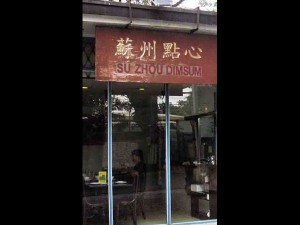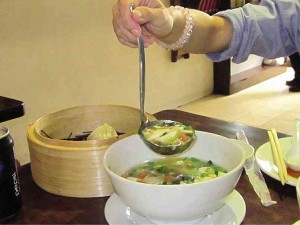It is a small unpretentious restaurant with an eastern Chinese cuisine in Mabini St., Mandaluyong City, within walking distance from Shaw Boulevard and near the Greenhills mall in San Juan City, Suzhou Dimsum (tel. 721-6105). In fact, the manager, Ling Que, calls it a “hole in the wall,” a “shophouse.”
And she explains: “A shophouse is a restaurant concept, half house and half resto/commercial place. We named it after Suzhou City near Shanghai, a nice place with gardens. Visit it if you have a chance to travel to China.”
She adds: “Those who are well travelled say our restaurant has a vintage shophouse look. They can tell because they travel a lot. It’s a ‘look and feel’ concept.”
The business started as a modest venture selling fried siopao with the brand name Ah!Pao, in honor of Ling’s grandfather, and established a partnership with a big Suzhou-type restaurant in Malate, Manila.
And then business began to expand.
The Mabini branch opened in 2005, followed a year later by the outlet in Promenade, Greenhills. Last year a third Suzhou Dimsum opened in Bonifacio Global City, Taguig.
Pretty and petite Ling, who took up not business administration but computer science at De La Salle University, says the Greenhills branch is more of a kiosk for moviegoers, while the BGC Dimsum at the Ayala Community Bldg. is “a little fancy and the urbanized Makati-Taguig crowd.”
The Mabini main branch has its own select clientele.
“We had the usual birth pains, adjusting and training people,” the manager notes. “But we had established a kind of cult following in Malate so we didn’t have a problem with customers.”
They eventually developed their own food for the Greenhills community, “our next-door neighbor,” and made deliveries to such upscale communities as Valla Verde in Pasig, White Plains in Quezon City, and Corinthian Gradens in Ortigas. The blogging community also featured the restaurant.
“Almost all Chinese food in Manila is Cantonese-influenced,” observes Ling, “and our food is different from the usual Cantonese. We are among the first players to promote xiaolong bao (soup dumpling) and eventually marami (many) did so. The big name brands came in three years ago. Some have eaten here.”
THE CHALLENGE for Suzhou Dimsum, the David among the Goliath Dimsums, was to keep up with the competition. Photo by Amadís Ma. Guerrero, Contributor
So the challenge for Suzhou Dimsum, the David among the Goliath Dimsums, was to keep up with the competition. “But we retained our customers,” says the manager. “We are very happy that they are loyal after sampling the competition.”
The restaurant serves dimsum, wonton, noodles with or without soup, steam-fried siopao, beef, pork, chicken, tofu, vegetables and congee, among other appetizing dishes. Prices range from P125 for the pan-fried xialong bao (“we are the only ones who have this, if I am not mistaken, very tasty”), to one whole crispy or spicy fried chicken (P480).
“We are a chicken country,” says Ling. “So our chicken has a Suzhou flavor. The skin is thick because we want to fry it. Mas makapal ng kaunti (a little bit thicker). The meat is local, to ensure freshness, but the condiments come from different parts of Asia.”
Another challenge is to keep costs down because they don’t want to scrimp on ingredients.
So how’s business? “It has stabilized through the years,” the manager concludes. “And it is getting better.”



